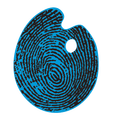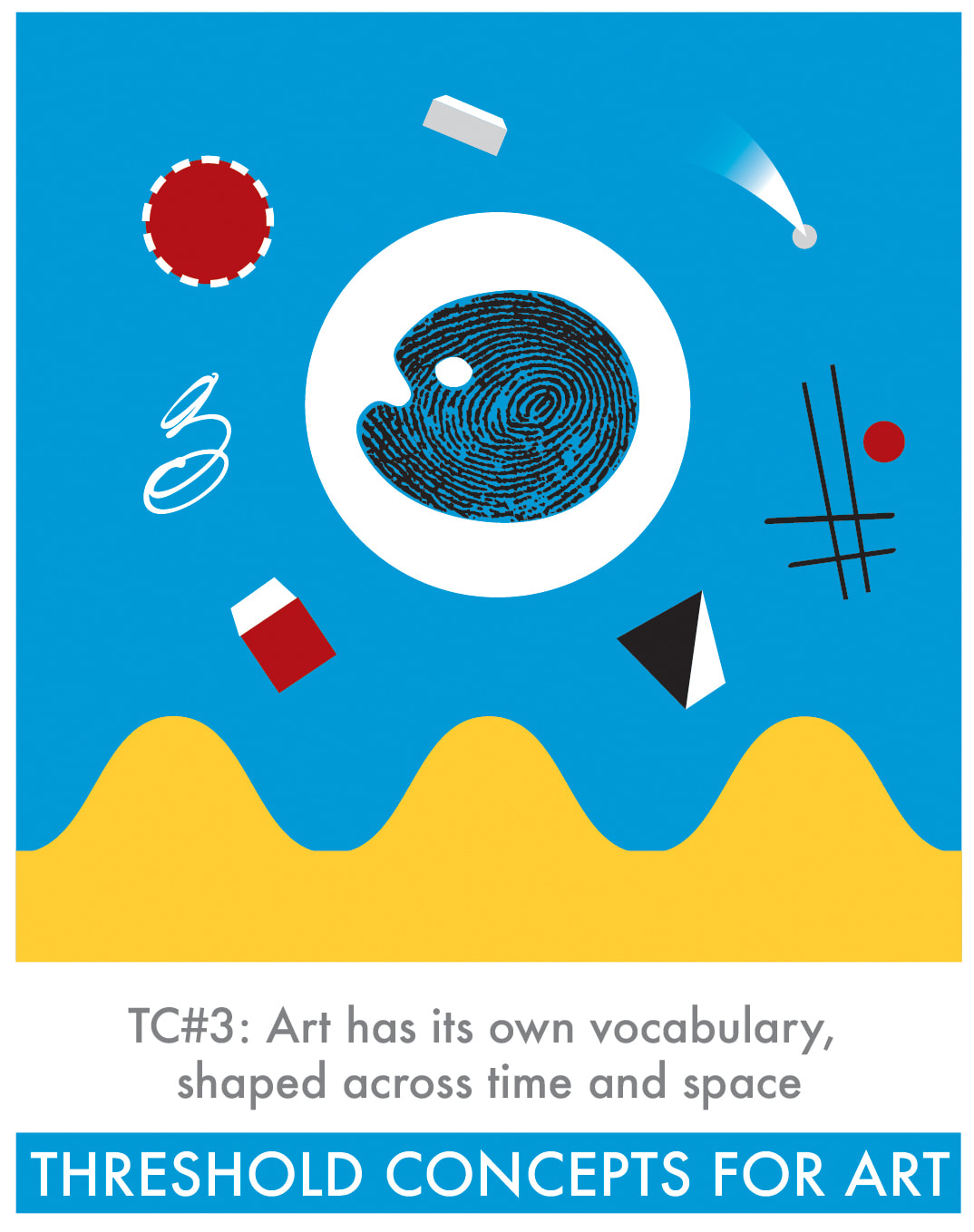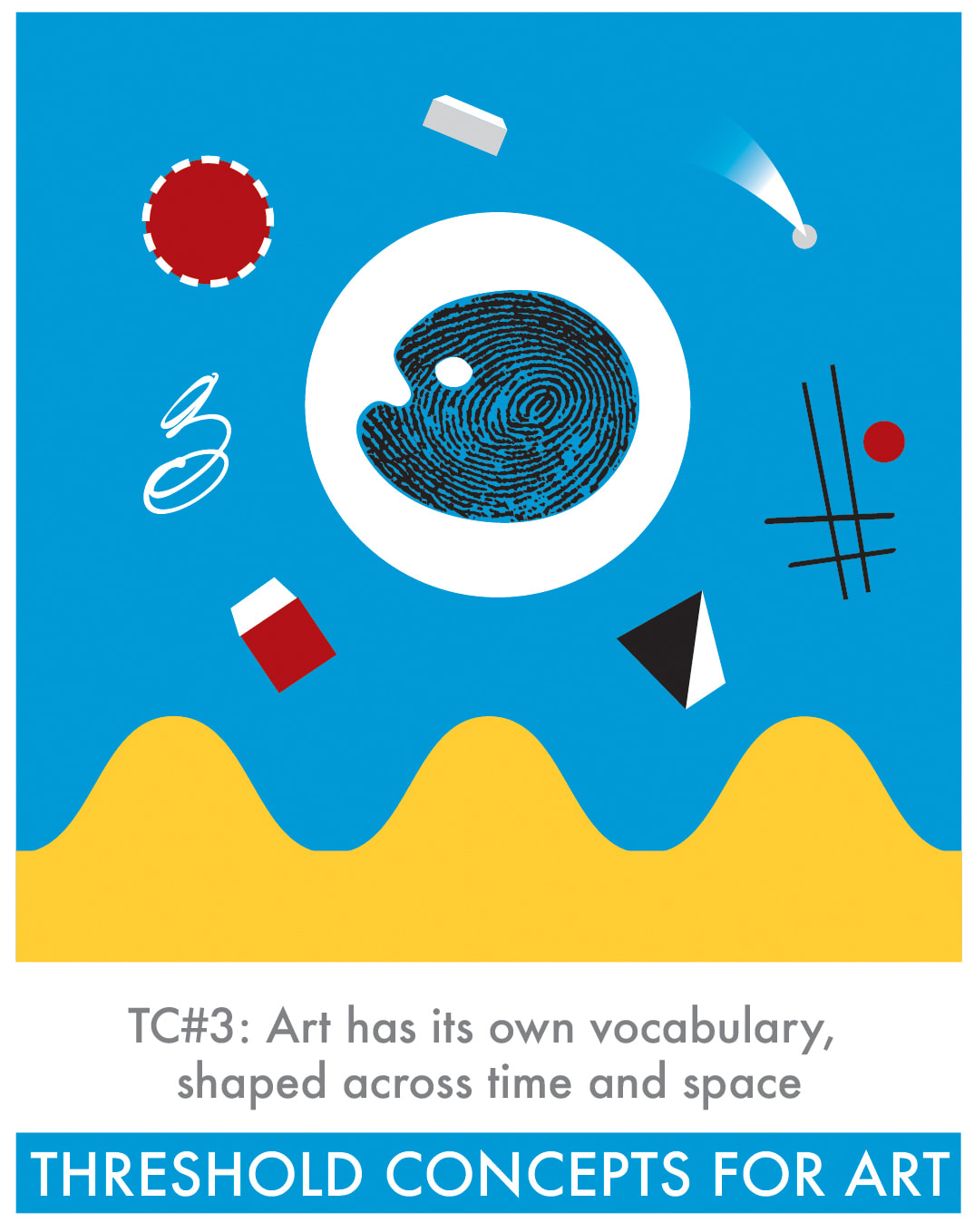TC#3: WORDS & ART
ABOUTThis resource has been designed for KS3 students but is suitable for all year groups. The key themes link closely with Threshold Concept 3: Art has its own vocabulary, shaped across time and space.
KEY THEMES
|
INTRODUCTORY TASK
Look carefully at The illustration for TC#3 and respond to the following prompts and questions.
|
IN PICTURES
The illustration for TC#3 (above) does contain shapes that have been inspired by various artworks - but not necessarily solely or definitively. Look at the examples below and see if any connections arise for you.
IN DISCUSSION
- Which images appeal the most to you, and which descriptive words help you to explain why?
- What connections from these images can you make to the TC3 illustration?
- Which of these artworks are trickier to understand or appreciate without further information? What questions could you ask to find out more?
- What visual connections can you make between the images in the grid - for example, similar subject matter, colours, textures, tones, shapes or compositions?
- Which of these artworks use similar materials and/or techniques?
- Which of these might you describe as sculpture? How about assemblage, installation, interactive or performance? Which of these words are new to you?
Below are links which provide further insights into the artworks above and the artists that made them. Listed in rows from top left.
- Francis Alÿs - When Faith Moves Mountains
- Roelof Louw Soul City (Pyramid of Oranges), 1967
- Ana Mendieta, Sandwoman Series, 1983
- Carl Andre, Equivalent VIII, 1966
- John Baldessari, Dots on photographs
- Cy Twombly, Gestural vocabulary
- Yoko Ono, action poems
- Marlow Moss, Spatial Construction in Steel, 1956-8
- Pyhlidda Barlow, Upturnedhouse2, 2012
IN words
The following words might prove particularly beneficial for this project:
- Visual elements: line (flow, weight), tone (light and dark), texture (surface), shape (flat, 2 dimensional), form (3 dimensional), space, pattern, colour.
- Composition, arrangement, layout, design; geometric, proportion, isometric, perspective
- Structure, scale, balance, tension, flow, weight, mass, motion
- Connection, association, representation, signified
In THE ARTROOM
POTENTIAL activitIes
- Choose two artworks from the examples in the grid, above. Investigate these in more depth. Add print-outs or sketch these in your sketchbook. Use key words, descriptive writing and/or thoughtful notes to show your growing awareness and opinions
|
- Use the slideshow, above, to consider what happens when two artworks are put side by side. See what happens when one artwork has different artworks and/or words next to it.
- Choose two (or more) artworks from the examples in the grid, above. Using drawing, painting and/or collage explore combining these in new and experimental ways. Also, think about their potential intentions and meanings and the words that help to describe these. How can all these things - the artworks (and/or photographs of them), their potential meanings, and their related words - be used to inspire you to make your own artwork?
- Below is an example of two different artworks that have been used to inspire an initial 'combination' response. The challenge with this task is to not just look for straightforward visual combinations, but also to identify ways in which artists, artworks, potential meanings and/or words can connect and cross-over to make the response more exciting, unexpected, personal and/or unique.
1. Three Figures from the Family of Man, Ancestor I, Ancestor II and Parent I, by Barbara Hepworth, 1970
2. Untitled Skull, Jean-Michel Basquiat, 1981
3. An initial student experiment, inspired by both artist works.
These two artists, above, might be described as quite different. One was English, grew up with a love of the countryside and received a formal art education; the other grew up in New York, in a less-settled family environment and became a graffiti artist. However, that's a simple summary. Art and artists - and life, actually - tends to be far richer and more complicated than simple summaries.
2. Untitled Skull, Jean-Michel Basquiat, 1981
3. An initial student experiment, inspired by both artist works.
These two artists, above, might be described as quite different. One was English, grew up with a love of the countryside and received a formal art education; the other grew up in New York, in a less-settled family environment and became a graffiti artist. However, that's a simple summary. Art and artists - and life, actually - tends to be far richer and more complicated than simple summaries.
- What might these two artists have in common, in their work and/or beyond? How can research and a curious mind help to find new, unexpected and imaginative connections?
- What would a collaboration by these two artists result in? What kind of artwork might they make together, and why?
- What would an imaginary conversation or email exchange between these two artists be like? Be careful to avoid stereotypical presumptions. Instead, try to place yourselves in their positions and think about what might then unfold.
The images above are taken from an #abstractadvent challenge to create an alternative art teacher's alphabet. Okay, they're quite silly and perhaps not entirely fair to students, but it can be fun to combine two (or more) different words to create a new one.
- Write out a list of art-related words. These might be descriptive words in response to the initial artist examples on this page. Alternatively, your teacher might show you some other artworks, or you might write words relating to the art room or related materials and techniques.
Once you have done this, experiment with chopping them up and rearranging these. What strange new words or poetry might you create? How might these new words help to describe something you've seen, experienced or imagined. How might you illustrate your new word inventions?
Below are some additional examples of artworks that use text in interesting ways. Roll over the images to see the artist names. Follow the links below to find out more.
From left to right, Cecil Touchon, PDP 289 (2005); Adam Pendleton, What is Black Dada? (2020); Fiona Banner, Full Stop for Greenpeace.
The activities above have introduced you to:
-how words might be used to describe artworks.
-how words can help to make connections between artworks and other things (other artworks, ideas, memories, sensations etc.)
-how artists might play with artworks and words, and even use words as art or within art.
The artwork 'Full Stop for Greenpeace' by Fiona Banner, above, is a wonderful example of art (and words - or punctuation marks, at least) having a powerful impact. Look at the sequence of images below and also consider the title of the artwork. What do you think might be happening and why?
Research the artist and this work. Consider how an artwork that you might create - with or without words - might be able to speak up as a force for good in the world.
-how words might be used to describe artworks.
-how words can help to make connections between artworks and other things (other artworks, ideas, memories, sensations etc.)
-how artists might play with artworks and words, and even use words as art or within art.
The artwork 'Full Stop for Greenpeace' by Fiona Banner, above, is a wonderful example of art (and words - or punctuation marks, at least) having a powerful impact. Look at the sequence of images below and also consider the title of the artwork. What do you think might be happening and why?
Research the artist and this work. Consider how an artwork that you might create - with or without words - might be able to speak up as a force for good in the world.
My art is the way I reestablish the bonds that tie me to the universe. ANA MENDIETA




























